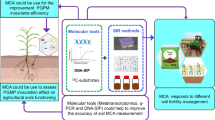Summary
Amendment of soils with arginine resulted in immediate liberation of ammonia. The rate was linear for several hours, and was strongly reduced by toluene treatment or under anaerobic conditions. Together with a strong stimulation of respiration by arginine these results demonstrate that arginine ammonification is due to living microorganisms. Arginine ammonification was strongly related to respiration and correlated significantly with the carbon content of the soil, but not or only poorly with soil pH, ammonia content, percentage clay or the number of microorganisms.
Similar content being viewed by others
References
Alef K, Kleiner D (1986) Arginine ammonification, a simple method to estimate microbial activity potentials in soils. Soil Biol Biochem 18:233–235
Alexander M (1977) Soil microbiology. Wiley, New York
Beck TH, Poschenrieder H (1963) Versuche über die Wirkung von Toluol auf die Mikroflora von Böden. Plant Soil 3:346–357
Birch JW, Melville M (1969) An electrolytic respirometer for measuring oxygen uptake in soils. J Soil Sci 20:101–110
Burns RG (1983) Extracellular enzyme-substrate interactions in soil. In: Slater JH, Whittenbury R, Wimpenny JWT (eds) Microbes in their natural environments. Cambridge University Press, Cambridge, pp 249–298
De Leenher L, Van Ruymbeke M, Maes C (1955) Die Kettenardometer-Methode für die mechanische Bodenanalyse. Z Pflanzenernähr Bodenkd 68:10–19
Harrigan WF, McChance ME (1966) Griess-Ilosvays reagent. In: Laboratory methods in microbiology. Academic Press, London
Kröckel L, Stolp H (1984) Influence of soil water potential on respiration and nitrogen fixation of Azotobacter vinelandii. Plant Soil 79:37–49
Ladd JN (1978) Origin and range of enzymes in soil. In: Burns RG (ed) Soil enzymes. Academic Press, London, pp 51–96
Norman RJ, Stucki JW (1981) The determination of nitrate and nitrite in soil extracts by ultraviolet spectrophotometry. Soil Sci Am J 45:347–353
Parkinson D, Gray TRG, Williams ST (1971) Methods for studying the ecology of soil micro-organisms. Blackwell, Oxford
Sepers ABJ (1981) Diversity of ammonifying bacteria. Hydrobiologia 83:343–350
Voets JP, Deneken M (1965) The behaviour of some amino acids in gamma irradiated soils. Naturwissenschaften 52:476
Waring SA, Bremner JM (1964) Ammonium production in soil under waterlogged conditions as an index of nitrogen availability. Nature (Lond) 201:951–952
Author information
Authors and Affiliations
Rights and permissions
About this article
Cite this article
Alef, K., Kleiner, D. Applicability of arginine ammonification as indicator of microbial activity in different soils. Biol Fert Soils 5, 148–151 (1987). https://doi.org/10.1007/BF00257650
Received:
Issue Date:
DOI: https://doi.org/10.1007/BF00257650




